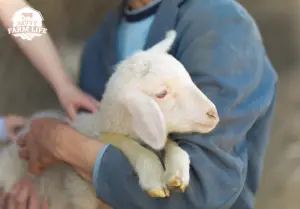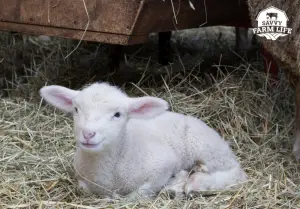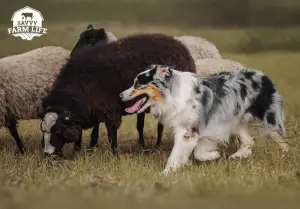
How to Hold And Handle Sheep
When caring for baby sheep, or lambs, from time to time you may need to pick them up and hold them.
So, how do you properly hold a lamb? To pick up a lamb, place one arm around its chest and one under its rump and scoop it up. Take care not to drop the lamb as this can damage its delicate body. Avoid holding a newborn lambs because this can interfere with the bonding process between the lamb and mother, and keep the lamb from getting colostrum.
Important Considerations When Holding A Lamb
Baby sheep are called lambs and are very cute. However, the time right after birth is not the time to attempt handling the lamb. It is very important that the newborn lamb and mother be left alone for a time. This is so that the lamb and mother can form a bond as they are supposed to so that they will be able to identify each other even in the midst of a large flock. This is also so that the lamb can nurse and receive the colostrum from the mother. 
Colostrum is the first bit of milk, and it is extra high in immune system boosters and other nutrients. A lamb that isn’t able to drink the colostrum is at risk of illness and even death. So please refrain from disturbing the mother and newborn lamb for at least a day or two to give them time to bond and the lamb time to nurse.
When you do decide to try handing a lamb, keep in mind that a mother will likely become violent if she doesn’t know you and you attempt to touch her baby. Even if you are a familiar human, she may not want you around her baby. And that’s perfectly normal. Give them some more time if needed.
Once some time has passed, it may be necessary to handle the lamb in order to move the sheep into a new pen, provide medical care, etc. To pick up a lamb, place one arm around its chest and one under its rump and scoop it up. Take care not to drop the lamb as you could injure its delicate body. Carry the lamb low to the ground so that the mother can see it. Usually the mother will follow with little argument as long as she can see the lamb.
How to Handle Sheep for Shearing
Sheep are usually shorn once a year or more, so it’s important to get a good understanding of how to safely get the necessary job done. A sheep won’t just stand there calmly through the prodding and loud noises while you shear it. Sheep first need to be put into a sitting position so they aren’t able to easily protest. This is safest for you as well as the animal.
Start by standing behind the sheep with its rump against your knees. Keep one hand on the rump and one under the chin.
Then gently push the head around toward the rump as you press the rump toward the floor into a sitting position.
Once its weight is no longer concentrated on its feet, hold the front legs and pull the animal the rest of the way up into a sitting position with its back against your legs.
How to Herd Sheep
A good alternative to directly handling sheep or lambs is to herd them. Here are some of the different sheep herding methods you can use.
Herding Sheep With a Dog 
A well-trained herding dog is a great asset to a shepherd. But the key word here is “well-trained.” A dog won’t just automatically know how to herd sheep effectively.
Trained sheep herding dogs know how to tell whether the flock is cohesive enough to be moved forward or if there are stragglers that need to be encouraged to rejoin the others.
The dog will go back and forth between putting stragglers back where they belong and driving the whole mass forward each time all the stragglers have been sent back into the herd.
Drive Sheep Yourself
The most common way to herd sheep without a dog is to take that shepherd’s crook and start walking at the sheep with it held in such a way as to make you look bigger and encourage the sheep to get moving. Sheep will typically only let you get so close before they’ll bolt, so you just need to get them to bolt in the direction you desire. Reach out with the crook to discourage stragglers from breaking off from the herd.
If you have a large herd or are moving a long way, you may need to enlist the help of some more people. Using multiple people to move a herd is very helpful to prevent the herd from breaking into smaller pieces along the way.
Use a Lead Sheep To Herd Other Sheep
Even though sheep form hierarchies within the herd, you can disrupt the pecking order to your advantage so that the sheep will follow you without any chasing or herding. It just takes a little advance planning.
Every year some of the offspring produced are kept as replacement lambs to keep the herd strong instead of sold for meat or breeding on another farm. If you bottle feed and bond with some of these replacement lambs, they will see you as the flock leader. And whenever you enter the pasture, those sheep will forget the other established pecking order and flock to you, their leader.
Because sheep are sheep, the other sheep will follow, even if the sheep bonded to you are lower on the hierarchy.
This is a great method for moving animals from one pasture to another. The only disadvantage is the requirement for previous planning, which also takes a great deal of time. But the advantages in the low stress to the sheep with this method, rather than scaring the sheep into running away from you to get them to move, are also very significant.
Train Sheep to Run to a Food Bucket Ahead of Time
Another low-stress method for sheepherding is to train the sheep to come running when they hear a bucket of food.
Do this by simply putting some food into a bucket and shaking it within hearing of the sheep. If no one is brave enough to investigate, then throw food from the bucket toward the nearest sheep. Eventually they will investigate and learn that food came from the bucket. Repeat this until the whole herd comes running whenever they hear the feed bucket.
Then when you need to move a herd, simply shake a bucket while they all follow you eagerly and without resistance wherever you want them to go.
How to Catch Sheep
Because of their flight instincts, sheep are pros at running for cover, which could prevent you from being able to handle them in the first place. They’ll leap over barriers and crash through walls to escape a perceived threat. And they’ll wander away if distracted. Even if you don’t have an escapee on your hands, you’ll still need to catch sheep from time to time for shearing, vet care, moving to a new pen, etc. Here are some of the best ways to catch sheep.
Hook the Neck with a Shepherd’s Crook
Yes, people do, in fact, still use shepherd’s crooks to catch sheep. It’s a very old method that still works today.
Sheep have very thin legs, so it’s typically safer to catch them by the neck if possible rather than by the leg. The neck is farther away from you though as you run after a retreating sheep, which makes capturing by the neck more challenging.
Hook the Sheep’s Leg with a Shepherd’s Crook
If you are unable to capture the sheep by the neck with the crook, you may have better look with the back legs. Typically shepherd’s crooks come with a hook on each end. The wider end is for the sheeps’ necks, and the longer, narrower end is for the legs.
Because the legs are thin and fragile, it is important to be as gentle as possible when crooking the leg. As soon as you manage to crook a leg, carefully and quickly walk your hands up the staff until you reach the sheep and can get a hand under the chin. Then release the crook and drop it immediately so your other hand can secure the rump or shoulders. This will keep the sheep from running forwards or backing up.
Corner and Pounce To Catch A Sheep
If you don’t have access to a shepherd’s crook, try getting the sheep into a corner and then catching it. An assistant or two with pig boards or similar herding walls may make your job easier by cutting off the only escape routes for the sheep. Move in quickly and get one hand under the chin and one behind the sheep to prevent launching forward or backing up.
Lure Sheep With a Treat
A less stressful method of capturing a sheep can be done by luring with a yummy-smelling snack. Walking into a place with a tasty morsel and then being trapped is stressful, but less stressful than being chased or cornered.
If possible, try luring the sheep into a secondary small pen from its paddock, then close the gate once it enters. Its best to still let it eat the treat though. It’s more likely to fall for the same trick next time you need it to if it is rewarded for the behavior than if it not only gets trapped, but also doesn’t get the treat it was tricked into the trap for.
Set a Trap To Catch Sheep
If you need to catch an escaped sheep and can’t be present at the trap all the time to trip the trap yourself when a sheep comes by, set a real trap that will be tripped by the sheep itself. You can purchase or build your own cattle trap to catch a missing sheep. And once again, those nice-smelling tasty treats will help encourage the sheep to give the trap a chance and investigate.
While sheep can be difficult to catch, they are fairly manageable to handle once you get ahold of them. Take care never to chase your sheep unnecessarily as that will make them flightier and more stressed. Whenever possible, use the lowest-stress method available for handling your sheep.
P.S. Save this article to your Sheep Care board on Pinterest!
